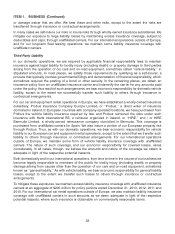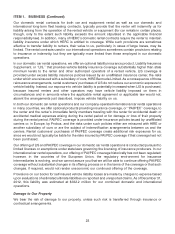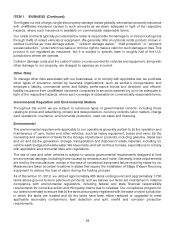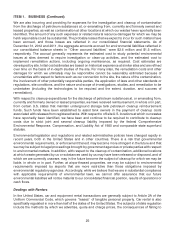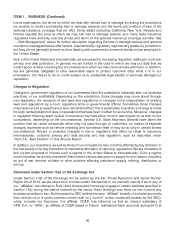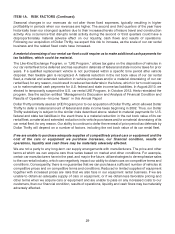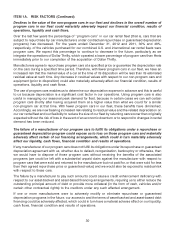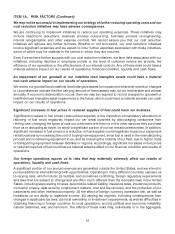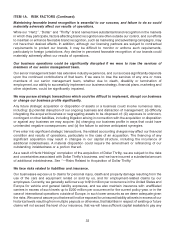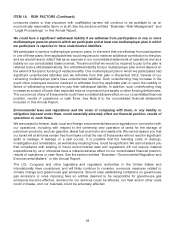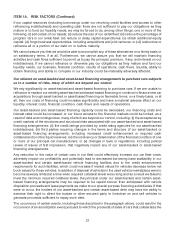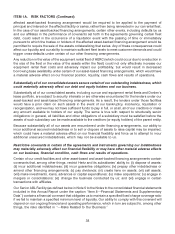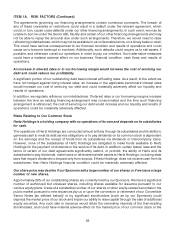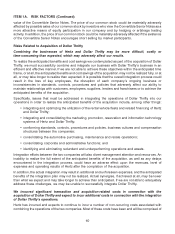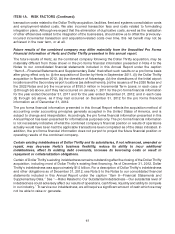Hertz 2012 Annual Report Download - page 55
Download and view the complete annual report
Please find page 55 of the 2012 Hertz annual report below. You can navigate through the pages in the report by either clicking on the pages listed below, or by using the keyword search tool below to find specific information within the annual report.ITEM 1A. RISK FACTORS (Continued)
We may not be successful in implementing our strategy of further reducing operating costs and our
cost reduction initiatives may have adverse consequences.
We are continuing to implement initiatives to reduce our operating expenses. These initiatives may
include headcount reductions, business process outsourcing, business process re-engineering,
internal reorganization and other expense controls. We cannot assure you that our cost reduction
initiatives will achieve any further success. Whether or not successful, our cost reduction initiatives
involve significant expenses and we expect to incur further expenses associated with these initiatives,
some of which may be material in the period in which they are incurred.
Even if we achieve further success with our cost reduction initiatives, we face risks associated with our
initiatives, including declines in employee morale or the level of customer service we provide, the
efficiency of our operations or the effectiveness of our internal controls. Any of these risks could have a
material adverse impact on our results of operations, financial condition, liquidity and cash flows.
An impairment of our goodwill or our indefinite lived intangible assets could have a material
non-cash adverse impact on our results of operations.
We review our goodwill and indefinite lived intangible assets for impairment whenever events or changes
in circumstances indicate that the carrying amount of these assets may not be recoverable and at least
annually. If economic deterioration occurs, then we may be required to record charges for goodwill or
indefinite lived intangible asset impairments in the future, which could have a material adverse non-cash
impact on our results of operations.
Significant increases in fuel prices or reduced supplies of fuel could harm our business.
Significant increases in fuel prices, reduced fuel supplies or the imposition of mandatory allocations or
rationing of fuel could negatively impact our car rental business by discouraging consumers from
renting cars, changing the types of cars our customers rent from us or the other services they purchase
from us or disrupting air travel, on which a significant portion of our car rental business relies. In addition,
significant increases in fuel prices or a reduction in fuel supplies could negatively impact our equipment
rental business by increasing the cost of buying new equipment, since fuel is used in the manufacturing
process and in delivering equipment to us, and by reducing the mobility of our fleet, due to higher costs
of transporting equipment between facilities or regions. Accordingly, significant increases in fuel prices
or reduced supplies of fuel could have a material adverse effect on our financial condition and results of
operations.
Our foreign operations expose us to risks that may materially adversely affect our results of
operations, liquidity and cash flows.
A significant portion of our annual revenues are generated outside the United States, and we intend to
pursue additional international growth opportunities. Operating in many different countries exposes us
to varying risks, which include: (i) multiple, and sometimes conflicting, foreign regulatory requirements
and laws that are subject to change and are often much different than the domestic laws in the United
States, including laws relating to taxes, automobile-related liability, insurance rates, insurance products,
consumer privacy, data security, employment matters, cost and fee recovery, and the protection of our
trademarks and other intellectual property; (ii) the effect of foreign currency translation risk, as well as
limitations on our ability to repatriate income; (iii) varying tax regimes, including consequences from
changes in applicable tax laws; (iv) local ownership or investment requirements, as well as difficulties in
obtaining financing in foreign countries for local operations; and (v) political and economic instability,
natural calamities, war, and terrorism. The effects of these risks may, individually or in the aggregate,
31



